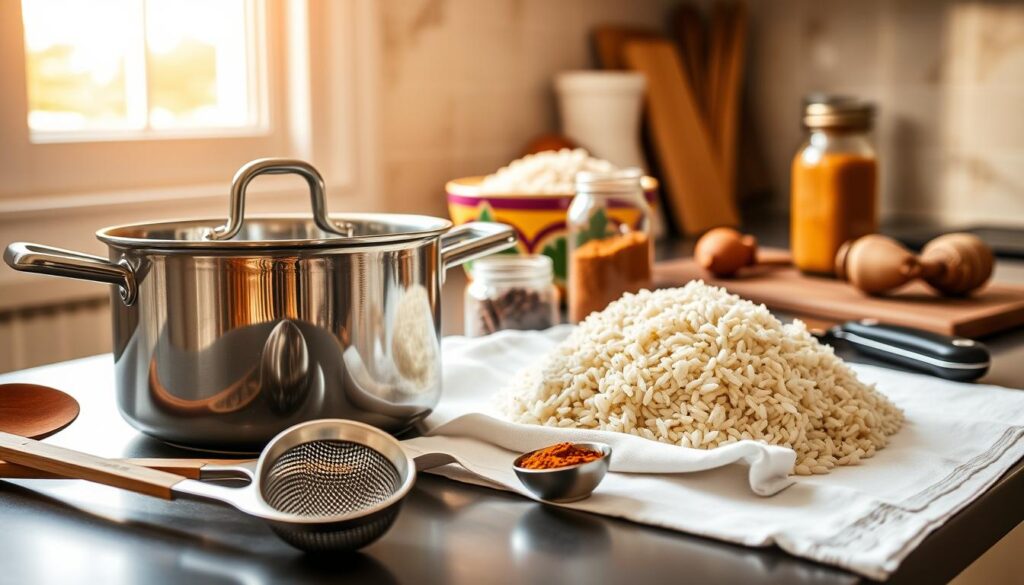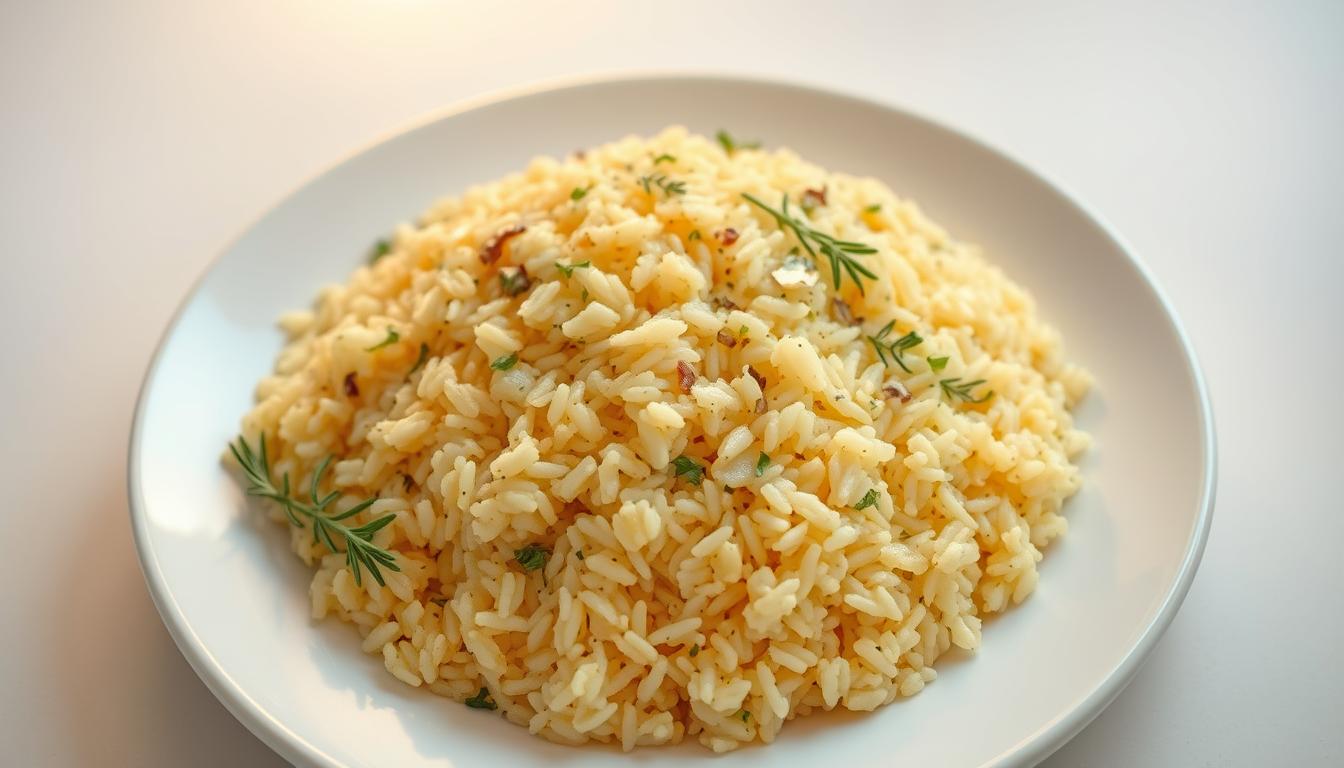Table of Contents
Imagine turning a simple side dish into a gourmet rice experience. The buttery herb rice pilaf is more than a recipe. It’s a journey that blends tradition with modern cooking. Your taste buds are in for a treat, turning ordinary rice into a special dining experience.
Pilaf is more than a cooking method. It’s a celebration of herbs, butter, and grains coming together. Whether you’re cooking for your family or mastering restaurant-quality rice, this guide will show you how to make a dish that stands out.
Key Takeaways
- Master the art of creating a luxurious buttery herb rice pilaf
- Understand the cultural significance of pilaf cooking methods
- Learn professional techniques for perfectly textured rice
- Discover herb combinations that elevate your rice dish
- Transform simple ingredients into a gourmet side dish
Understanding the Perfect Buttery Herb Rice Pilaf
buttery herb rice pilaf is a journey through time and cultures. It turns simple grains into a flavorful dish. Learning about traditional pilaf can make you a better cook and appreciate this classic recipe more.
Origin and Cultural Significance
The history of buttery herb rice pilaf goes back to the Middle East and Central Asia. Nomads created it as a nutritious meal with few ingredients. Each area added its own spices and cooking ways.
- Persian cuisine introduced elaborate pilaf variations
- Ottoman Turkish chefs refined the cooking technique
- Mediterranean cultures embraced pilaf as a staple dish
Key Components of Traditional Pilaf
Traditional pilaf is special because of its cooking method. Rice is toasted before adding liquid. This makes each grain separate and adds a rich flavor.
| Component | Purpose |
|---|---|
| Aromatics | Onions, garlic, and herbs for depth of flavor |
| Fat | Butter or oil to toast grains |
| Liquid | Stock or water for cooking rice |
What Makes it Different from Regular Rice
Pilaf and regular rice are different in cooking. Pilaf is made with care, changing its texture and taste. It has separate grains, rich flavors, and a complex cooking process.
- Texture: Fluffy and distinct grains
- Flavor: Rich and aromatic
- Preparation: More complex cooking method
Essential Ingredients for Your Rice Pilaf
Making a tasty buttery herb rice pilaf begins with picking the right ingredients. The base of a great pilaf is quality rice. It soaks up flavors and gets the perfect texture. Butter is key in adding richness and depth to the dish.
Let’s look at the main parts that make rice pilaf special:
- Rice Base: Long-grain white rice or basmati are best for a traditional pilaf
- Fat Component: Unsalted butter gives the most authentic taste
- Herbs for pilaf: Fresh herbs like parsley, thyme, and rosemary add vibrant taste
Herbs can really boost the flavor of your buttery herb rice pilaf. Fresh herbs add a bright taste, while dried herbs pack a stronger punch. Here are some great herb mixes:
- Mediterranean blend: Oregano, parsley, and mint
- Classic blend: Thyme, rosemary, and sage
- Citrus-herb mix: Lemon zest with dill and chives
For butter, choose high-quality unsalted butter. It lets you control the salt and makes the rice creamy and well-coated.
Choosing the Right Type of Rice for Pilaf
Choosing the right rice is key to a buttery herb rice pilaf. The right grain can make your dish unforgettable. It turns a simple meal into a memorable experience.
The rice you pick is very important for pilaf. It affects the texture and taste of your dish. Long-grain rice is the best choice for pilaf. It makes the dish stand out.
Understanding Rice Grain Differences
Rice comes in different sizes, but long-grain is best for pilaf. It stays fluffy and separate after cooking. This makes your pilaf light and tasty.
- Long-grain rice maintains its structure during cooking
- Provides excellent separation between grains
- Creates a lighter, more delicate pilaf texture
Popular Rice Varieties for Pilaf
Basmati rice is a favorite for buttery herb rice pilaf. It has a light, fragrant smell and looks elegant. Its slender grains and nutty taste make it perfect for a high-quality pilaf.
Rice Quality Indicators
When picking rice for pilaf, look for these signs:
- Clean, uniform grain appearance
- Minimal broken grains
- Subtle, pleasant aroma
- Consistent grain length
Pro tip: Always choose premium-grade long-grain rice for the best pilaf.
Kitchen Tools and Equipment Needed

Making the perfect buttery herb rice pilaf needs more than just ingredients. The right cookware can greatly improve your cooking experience and the taste of your dish. Choosing the right tools ensures your rice is cooked evenly and has a great texture.
Your essential rice pilaf cookware should include:
- Heavy-bottomed saucepan or Dutch oven
- Sharp chef’s knife for herb preparation
- Fine-mesh strainer for rinsing rice
- Accurate measuring cups
- Wooden spoon or spatula
A heavy-bottomed pot is key for cooking buttery herb rice pilaf. Cast iron or stainless steel pans distribute heat evenly, preventing rice from burning or sticking. These materials keep the temperature consistent during cooking.
| Cookware Type | Heat Distribution | Best for Pilaf |
|---|---|---|
| Cast Iron | Excellent | Perfect heat retention |
| Stainless Steel | Good | Even cooking surface |
| Non-Stick | Fair | Easy cleaning |
Investing in quality rice pilaf cookware is worth it. It will last for years. A good set of tools can make a big difference in your cooking and help you get this dish right.
Preparing Your Herbs and Aromatics
Making a tasty herb rice pilaf begins with picking the right herbs. The herbs you pick can turn a simple rice dish into a feast for your senses.
It’s important to know the difference between fresh and dried herbs. Fresh herbs add lively flavors and scents that make your pilaf stand out.
Fresh vs. Dried Herbs
Fresh herbs have a stronger taste than dried ones. Here’s how to use them:
- Add fresh herbs at the end of cooking
- Use dried herbs while cooking
- Herbs like rosemary and thyme stay potent when dried
Herb Combinations That Complement Pilaf
Try these herb mixes for a great pilaf:
- Parsley and dill for a light taste
- Thyme and rosemary for a rich flavor
- Mint and cilantro for a zesty kick
Storing Fresh Herbs
Keeping fresh herbs fresh is key. Wrap them in damp paper towels and store in a sealed container in the fridge. They’ll last 5-7 days this way.
Tip: Chop herbs right before adding them to keep their oils and flavor in your pilaf.
Step-by-Step Buttery Herb Rice Pilaf Method
Learning to make rice pilaf needs attention to detail. This guide will help you make a tasty, fragrant dish. It turns simple rice into a gourmet treat.
- 2 cups long-grain white rice
- 4 tablespoons butter
- 1 diced onion
- Fresh herbs (parsley, thyme)
- 4 cups chicken broth
- Salt and pepper to taste
Melt butter in a big skillet over medium heat. Add diced onions and cook until they’re clear, about 3-4 minutes. This step lays the flavor base for your pilaf.
Then, add uncooked rice to the skillet. Stir continuously to cover each grain with butter. This toasting step adds a nutty, rich taste that makes pilaf special.
- Pour in chicken broth
- Add chopped fresh herbs
- Season with salt and pepper
- Bring mixture to a gentle boil
- Reduce heat and cover
Let the rice simmer for 18-20 minutes, until all liquid is gone and rice is soft. After cooking, cover it for 5 minutes to get the perfect texture.
Your buttery herb rice pilaf is now ready to serve. It’s a tasty side dish that makes any meal better!
The Secret to Perfect Rice Texture
Making the perfect rice pilaf is an art that needs precision and understanding. It’s not just about boiling rice. It’s about finding the right balance of ingredients and cooking methods.
To make an amazing rice pilaf, you need to focus on three key things. These factors turn regular rice into a true culinary delight:
Mastering the Rice-to-Water Ratio
The right rice-to-water ratio is key for perfect rice texture. Each type of rice needs a different amount of water:
- Long-grain rice needs 2 cups of water for every 1 cup of rice.
- Medium-grain rice requires about 1.5 cups of water.
- Basmati rice does best with 1.75 cups of water for every 1 cup of rice.
Precision in Cooking Time and Temperature
Controlling the temperature is vital in making rice pilaf. Here’s what to do:
- Start with medium-high heat to begin cooking.
- Lower the heat to low once the liquid starts simmering.
- Keep the heat low to cook evenly.
The Magic of Resting Rice Pilaf
The resting period is a key step for fluffy, separated grains. After cooking, let your rice pilaf rest covered for 5-10 minutes. This step helps the moisture spread evenly, making the rice light and tender. It takes your dish from good to great.
Conclusion
Mastering rice pilaf is an art that turns a simple side dish into a masterpiece. Your journey through pilaf cooking tips shows the balance of ingredients, techniques, and passion needed. Each step, from choosing premium rice to selecting herbs, is key to rich flavors.
Rice pilaf is versatile, making it a must-have in any home cook’s collection. You can try different herbs, explore regional flavors, and adjust the basic method to your liking. It’s perfect for any meal, from weeknight dinners to special gatherings.
Now you know how to make pilaf, and you can improve your cooking. With practice and patience, you’ll get better at making this dish a highlight of your meals. Great cooking is about knowing the basics and then adding your own twist.
Start cooking rice pilaf with confidence. Each time, you’ll get better at it, enjoying the process more. So, go ahead, try new things, trust your instincts, and enjoy the tasty outcomes of your cooking adventures.

